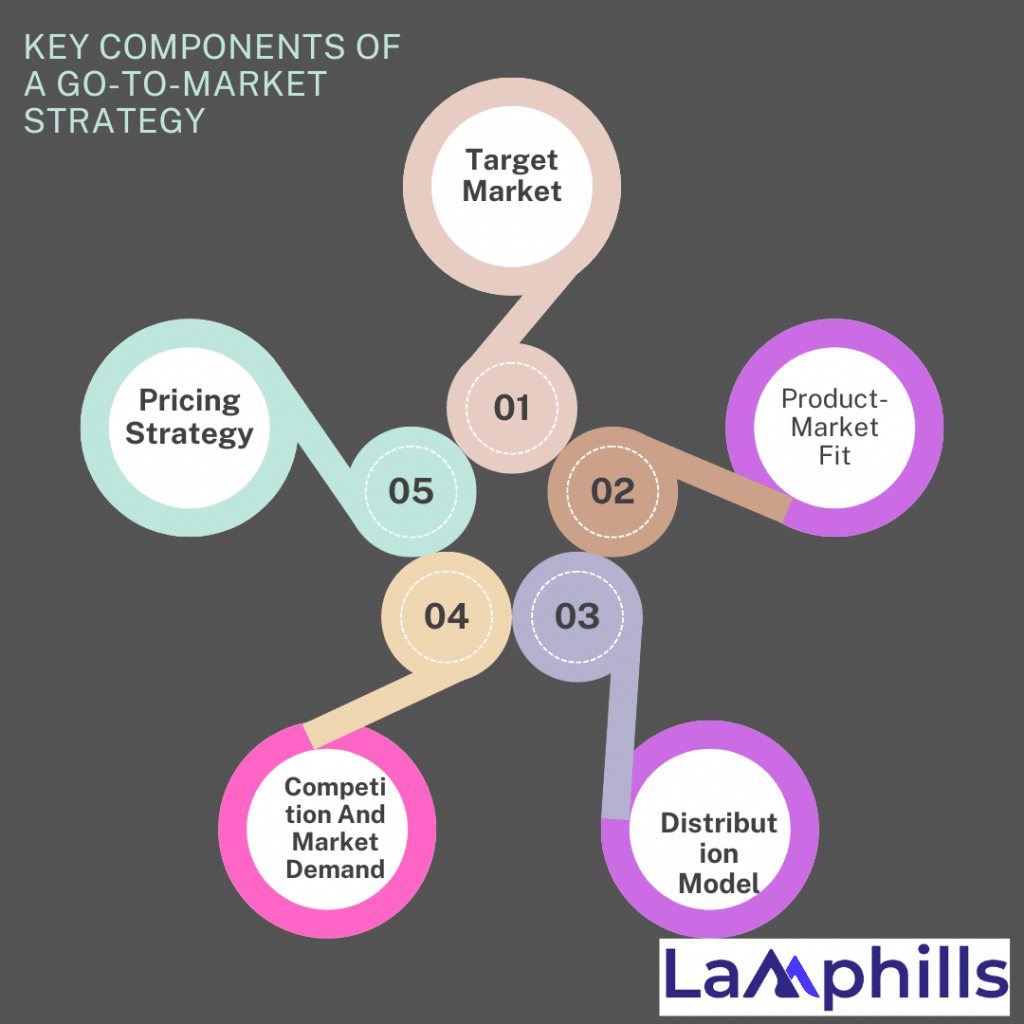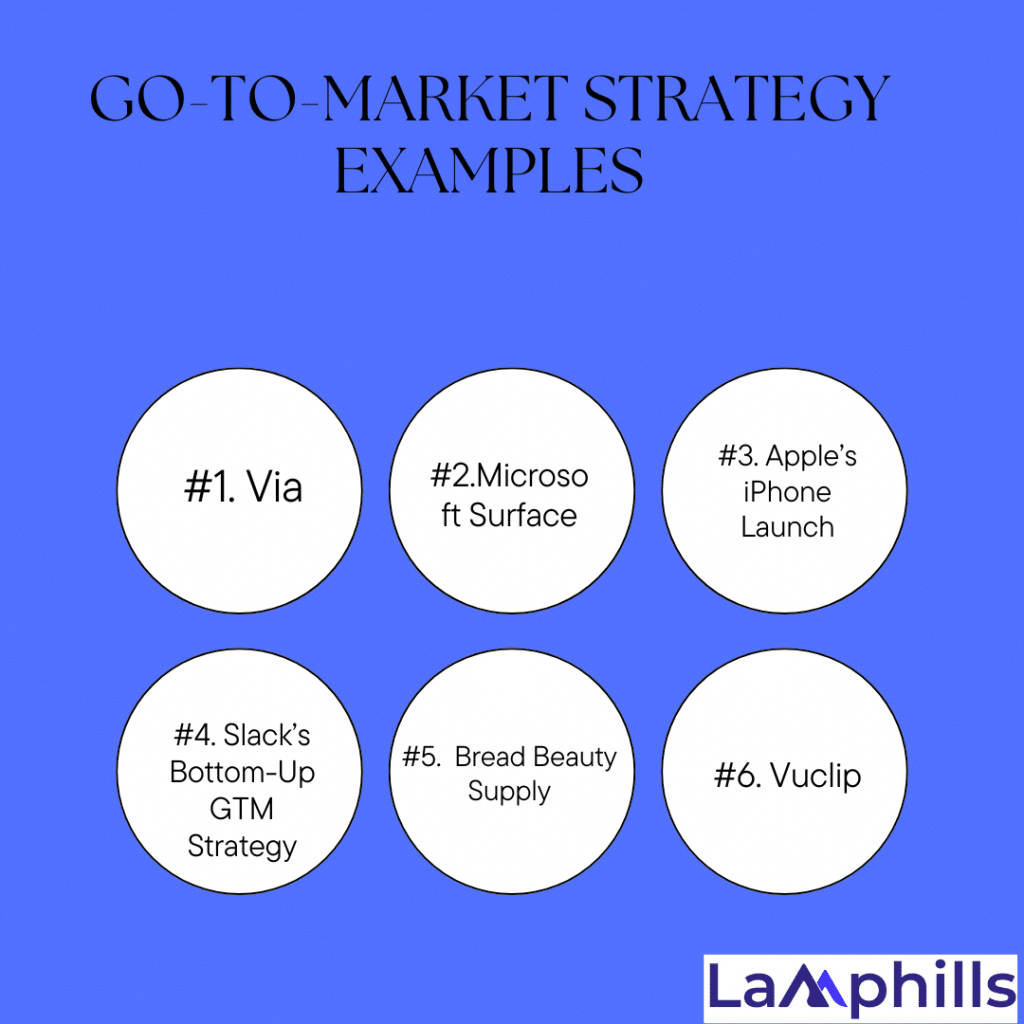Introducing a new product is one of the most exciting aspects of operating a business. But, as I’ve seen firsthand, it’s not all excitement. The butterflies in your stomach while presenting a new product can rapidly turn into knots if you don’t have a sound go-to-market (GTM) strategy in place. Now, this is because no corporation wants to launch an unprofitable product or target the wrong market. That is why businesses should develop and launch successful goods using a deliberate and well-thought-out go-to-market strategy.
To ensure a successful product launch, create a comprehensive, actionable, and effective go-to-market (GTM) plan framework. Without appropriate planning, it’s impossible to tell if you’re chasing the wrong audience, are too early or too late for a given market, or targeting a market that’s too saturated with similar solutions. To make the process easier, In this article, I’ll share some of the most effective GTM strategies and examples you can draw inspiration from for your business. Are you ready to see how it’s done? Let’s go!
Key Takeaways
- The success of a product launch hinges on understanding your target market deeply. For instance, Via’s focus on ride-sharing met the needs of commuters better than competitors, and Microsoft’s Surface catered to users seeking a blend of tablet portability with laptop functionality.
- Real-world examples, such as Apple’s strategic use of exclusivity and Slack’s bottom-up approach, illustrate how diverse tactics can lead to successful product launches. These cases show that understanding and applying proven strategies can significantly enhance your own GTM efforts.
- A mini-launch or pilot test, as highlighted with the example of Bread Beauty Supply, allows you to gather feedback and make necessary adjustments before committing to a full-scale launch. This approach can save resources and refine your strategy based on actual market reactions.
- Ensuring alignment among sales, marketing, and product teams is crucial. Successful GTM strategies, like those used by Microsoft and Apple, demonstrate that cohesive teamwork can drive a product’s success by aligning all efforts toward a common goal.
What Is a Go-To-Market Strategy? And How to Create One

A Go-to-market strategy is a thorough plan that describes how a product will enter the market and how the company will reach its target audience. It covers everything from identifying the ideal consumer to selecting the best distribution channels, defining your value proposition, and developing your sales and marketing strategies.
Simply put, it’s a road map for how you want to market your product and gain clients. A typical GTM strategy includes target market profiles, a marketing plan, and a concrete sales and distribution strategy, all of which are intended to reduce the risk associated with the launch of new products. lastly, developing a go-to-market strategy is equally vital for established businesses as it is for new entrepreneurial ventures.
Key Components of a Go-to-Market Strategy

What should every go-to-market strategy include? Before we dive into the examples, let’s break down the key components that every GTM strategy should consist of:
#1. Target Market
The first and most important stage is to define who your ideal consumers are. It’s tempting to assume that your product is for everyone, but limiting down your target group is critical. The tighter the emphasis, the better your marketing will be.
Which segment of the market is perfectly suited to your products and services? Determine who you want to reach and what message you want to give out. If you want to reach Gen Z, you should make your material useful, bite-sized, and visually appealing, and use relevant channels like TikTok.
#2. Product-Market Fit
Another important component is a thorough market and competitive study. To avoid entering an overcrowded market, you must first understand where you fit in and how you can separate yourself. The more you understand about your competition, the more effectively you can position your goods.
So, examine whether your product addresses a big market need. When your solution solves problems for a certain group of customers, you have product-market fit. Getting the perfect match is critical for a successful business.
#3. Distribution Model
Choosing appropriate sales channels is a crucial decision. Are you going directly to consumer? Are you selling through retail? Partnering with third-party distributors? Your distribution plan should reflect how your target customers want to shop.
To do this. think of idea model you want to set up for your product. One of the major deciding factors when choosing a distribution model is the type of customer you want to target. Discover if they prefer to use a standalone website, social media platform, or mobile application.
#4. Competition And Market Demand
Review the market to see if customer needs are being adequately met. Avoid an over-saturated industry or one with very few companies, as that may signal a lack of significant demand. Instead, position your brand by highlighting its unique selling proposition.
#5. Pricing Strategy
How you price your product can be a deciding factor in whether customers bite. Are you pricing it as a premium product or competing on affordability? Both approaches can work, but it depends on your market positioning.
How to Create a Go-to-Market Strategy
A go-to-market strategy combines multiple other strategies and marketing approaches to ensure that a product enters the market with the best possibility of success. To assist you in understanding what goes into creating a GTM, the following guide lists crucial elements you should build throughout the process.
#1. Establish Realistic Launch Goals
A common mistake is to believe that a new product will be a revenue-generating game changer. When you do this, you will overspend on marketing and manufacturing, risking not breaking even.
Always presume that your new product will not generate more revenue than your existing products. It is better to be pleasantly surprised than profoundly dissatisfied. Remember, your sales estimate is there to keep you accountable.
#2. Set Deadlines
Task deadlines Keep your team on track and make sure your product is released on time. Just make sure that all of your departments’ deadlines coincide so that sales, inventory, marketing, and finance are all on the same page on launch day.
#3: Determine Your Product’s Core Value Proposition
Before you begin your new product journey, consider what you want your firm to benefit from the product. New goods are costly to develop and market with no assurance of sales, so if the answer is unclear, try asking yourself some of the following questions:
- Why are you launching?
- Have customers requested updates on older products?
- Are you looking to increase quality?
- Do you plan to offer a cheaper solution?
- Are you going head-to-head on a competitor product?
- Tip: Know where your new product falls in your company’s value chain to ensure it’s doing its job.
#4. Define Your Target Customer
Understanding your audience is one of the most important parts of a successful GTM plan. As you think about your ideal customer, consider the following:
- What pain points are they experiencing?
- How can you resolve their problem(s)?
- How does the customer feel about their current situation?
- What features are most important to your target customer?
- How do they intend to use your product?
- Tip: Use data to segment customers and create buyer personas to refine product messaging.
#5. Select Your KPIs
You can’t assess the success of your strategy if you don’t know exactly what you’re measuring. For example, do you want to track conversions, brand awareness, customer retention, or something else?
When you start tracking your metrics from the very beginning with sales funnel software, it’s easier to pinpoint any problems and find solutions. A few of our KPI suggestions include:
- Number of visits to your product page
- Number of inbound interactions
- Revenue per customer
- Cash burn rate
- Customer satisfaction score
- Number of ad clicks
- Number of outbound interactions
#6. Analyze and Repurpose Old GTM Strategies
If you’ve used a GTM method before and it succeeded, consider employing it again. Consistency benefits both your organization and your customers.
Brand consistency means that your prospective and repeat customers will feel comfortable purchasing from you. A drastic adjustment in approaches can occasionally backfire and erode client trust.
#7. Complete Sales Cycle And Choose Data-Gathering Techniques
If you know your sales team is working on cycle adjustments and new sales strategies, make the necessary enhancements before you launch. Changing or compressing a sales cycle typically necessitates a significant amount of experimentation. If you are attempting to evaluate sales data on a new product during cycle changes, you will be unable to isolate your product data from your sales activity data.
Tip: If you’re expecting internal updates, plan out all product and sales-related activities at least a year in advance, so your product launch team isn’t tripping over other departments.
#8. Optimize Lead Funnels
It doesn’t matter how much you hone in on your target audiences or buyer personas—each new product will have its niche.
A new audience niche means your teams need to take the time to do a bit of market research, create a new market strategy, and optimize your lead funnel for maximum conversions. If your new product is a huge shift for your company, it’s worth updating your prospecting strategies and creating an alternate sales pipeline.
Tip: Pack your lead funnel with prospects who are a good match for your new product before you officially launch.
#9. Align Sales Activities With The Customer Journey
Sales activities will vary based on where your prospect is in the customer journey. Here are some examples of activities your sales reps can do as a buyer progresses through the sales funnel:
- Awareness: Let buyers know you’re an option through prospecting and marketing.
- Discovery: Score leads and schedule discovery meetings to assess their needs.
- Evaluation: Send the prospect a proposal.
- Intent: Negotiate and finalize the contract.
- Purchase: Collect payment and send the buyer to onboarding.
- Loyalty: Deliver the product and follow up for customer feedback.
Tip: Clearly outline what actions you expect salespeople to take at each stage of the sales funnel to ensure consistency across your entire organization.
#10. Prepare Your Customer Service Team
Nobody wants to think about product concerns during a launch, yet new goods are always met with an inescapable flood of customer questions and complaints.
That is why it is vital to inform your customer support personnel about new items and prepare them for any known concerns.
Tip: Organize product demonstrations for your support personnel to ensure they have the skills to handle client queries when they arise.
#11. Plan a Mini-Launch To Test Performance
Your launch does not have to be from zero to sixty with no seatbelts on. If you’re venturing into new terrain, consider hosting a mini-launch with a small group of loyal, valued consumers.
These customers know your brand, therefore, they’re eager to provide insights about the product’s successes and failures. Mini-launches can also be huge money savers. If you find out your product needs to go back to the drawing board, you’re not stuck shutting down a full-size launch.
Go-to-Market Strategy Examples

To give you a clearer idea of how these strategies come together, let’s dive into some real-world examples of successful GTM strategies.
#1. Via
Via is a ridesharing network that launched in 2012 when Uber was still relatively unknown. While Uber has surpassed Via in popularity and product usage, Via has successfully carved out a niche in the transportation technology market.
The company’s GTM approach emphasizes ride-sharing, which means riders share rides with other riders heading in the same route. The driver follows a predetermined path and drops off riders at convenient spots rather than picking them up at private locations. Via set out to address a frequent complaint among commuters: overcrowded or unavailable public transportation with rigid routes.
Another pain issue for the target group was Uber and Lyft rides were costly and unsuitable for regular commutes. Via addressed this issue by developing a legitimate ridesharing service capable of filling the gaps left by Uber and Lyft.
Now, the company collaborates with private transit operators, schools, and public transportation agencies to expand existing operations or give more riding options to consumers. As a result of Via’s go-to-market approach, the company no longer considers Uber a direct rival.
#2. Microsoft Surface
Microsoft Windows has long been the dominant operating system, and for good reason: the majority of computer manufacturers provide Windows laptops and desktops. So, since Microsoft’s software is so widely used, why would the company introduce its own line of laptops and tablets?
Microsoft’s go-to-market strategy for its Surface products aimed to address a frequent issue for tablet consumers. Tablets were essentially mobile devices; while they were easy to transport, they lacked the complete capabilities of laptops. Furthermore, many people could not afford to acquire both a tablet and a laptop.
When Microsoft unveiled the third iteration of the Surface tablet, it made its intentions obvious. The device was a fully operational computer in tablet form.
You could have a light device without sacrificing function. Compared to the Apple iPad, its principal competitor, the Surface tablet offered more functionality at the same price.
Now, the Microsoft Surface line has expanded to include laptops and desktops. Microsoft realized that laptop buyers may not purchase a Windows laptop because there are so many manufacturers to choose from. Specifications and hardware components vary from machine to machine.
With its Surface laptops, Microsoft makes the choice easier for target demographics such as college students and everyday users. These devices compete with Apple’s macOS offerings and are designed to seamlessly integrate with all of the features of Windows OS.
#3. Apple’s iPhone Launch
When it comes to renowned product launches, Apple’s iPhone always ranks at the top. Apple understands how to generate excitement and exclusivity like no other brand. They didn’t just introduce a phone; they developed a must-have lifestyle item.
Apple concentrated on arranging private launch events, keeping their product a secret until the big reveal. They also used a robust pre-order approach to make their product introduction feel like something no one wanted to miss. What are your takeaways from this? If you can instill a sense of suspense and exclusivity, you’ve already won half the battle.
#4. Slack’s Bottom-Up GTM Strategy
Slack did not begin by attempting to market to large organizations. Instead, they targeted the users—the employees themselves—and allowed the product to expand organically. They adopted a freemium approach, providing a basic version of the software for free, allowing individual users to fall in love with the service before encouraging their employers to use it.
I recall working with a client that was launching a collaborative product, and we used Slack to guide our GTM strategy. We witnessed considerably faster growth than we expected by focusing on individual users and allowing them to act as our champions throughout their businesses.
#5. Bread Beauty Supply
Bread Beauty Supply, a Black- and woman-owned hair care brand, set out to address a prevalent issue among its curly-haired customers: overly intricate procedures that waste time, energy, and product.
The brand debuted in 2020 and works with Sephora as its primary distribution channel. In its go-to-market approach, the company identified a buyer category that prefers to keep their routine simple and their curls natural.
Compare this strategy to that of competitors like Pattern Beauty and Ouidad, who both provide a plethora of hair care products that can make purchasers dizzy, confused, and overwhelmed. When developing their go-to-market strategy, Bread Beauty Supply realized that some people with curly hair would rather spend less, not more, time on their hair.
Image Source
While the curly hair care industry verges on overcrowded, Bread Beauty Supply successfully launched by taking a unique stance in the industry.
#6. Vuclip
Vuclip, a mobile video-on-demand service, tapped into emerging markets with limited access to high-quality video streaming services. Consumers in these areas — including India, Thailand, and Egypt — dealt with slow video buffering speeds due to a lack of advanced mobile networks.
Image Source
The company’s go-to-market strategy was based on appealing to those “must-have” areas, where it could gain a competitive edge by providing an accessible platform that solved regional consumers’ buffering needs.
What was the result? Vuclip has over 41 million subscribers across 3,000 cities and wants to expand into even more underdeveloped communities throughout the world.
#7. Upscope
Upscope, an interactive screen sharing tool, emerged as a resource for a more technically oriented audience than its competitors, specifically onboarding, support, and IT specialists.
The key pain issue the company sought to alleviate was the problem consumers had when trying to share their screens—particularly when it came to walking prospects, customers, or employees through technical subject matter.
The company addressed that issue by creating a solution that lends itself to instant and interactive screen sharing — sparing users the trouble of fumbling through the screen share process and letting all parties engage with the content they’re seeing.
Image Source
Upscope supported its go-to-market efforts with a solid content marketing strategy — maintaining an active web presence and blog. It also incorporated integrations with other tools into its solution, giving itself more visibility and clout.
#8. Baggu
Baggu is a reusable bag brand. While it appears straightforward on the surface, its go-to-market strategy has sparked interest in the sustainability community.
This brand was created to reduce waste by sustainably managing deadstock products and fabric. This appeals to environmentally aware consumers who want to reduce their use of plastic bags. Baggu’s relevant purpose has led to numerous collaborations, transforming its items from functional to elegant show pieces.
Baggu recently collaborated with Joonbug, a Jamaican artist recognized for amazing skate graphics, to create vibrant patterns that reflect his cultural heritage and style.
The products are visually interesting, eye-catching, and were marketed through Instagram — a social media platform designed for visual ads and promotion, and a perfect vehicle for a mutually beneficial collaboration for JoonBug, who is also a prominent influencer in the art sphere.
#9. Thinx
Thinx is a feminine hygiene firm that provides period-specific underwear. This reimagined approach to menstrual products is gaining popularity in the industry, and its go-to-market strategy has contributed to its success.
Spending a lot of money on one-time sanitary items is a common source of frustration for those who have periods, and it’s also bad for the environment. So, selling washable underwear with a two-year guarantee is a far better investment than the alternative.
Thinx is also renowned for collaborating with organizations that use cause marketing, such as the Black Mamas Matter Alliance. BMMA focuses on the topic of maternal health, particularly for black women who are three times more likely to die from childbirth than other races) that Thinx’s audience would also care about or be aware of.
This strategy appeals to consumers who can feel good knowing they’re buying something that gives back a portion of profit to something beyond themselves, especially if it raises awareness of inequalities in maternal health.
#10. Metaverse
One of the more ridiculous ideas in recent go-to-market strategies is the creation of the Metaverse. Facebook created an immersive digital economy that serves as a glimpse into the platform’s future.
This business knows that people are living more digitally than ever before, which includes more online purchasing – but without the in-person shopping experience. While it is more easy to add products to your cart with a few clicks, buyers miss out on the experience of shopping in a physical store.
Metaverse addresses this issue by combining the traditional brick-and-mortar experience into a VR-centric digital reality.
Image Source
In addition to resolving the online purchasing conundrum, the PR campaign and influencer marketing were such a great success on one of the most popular social media platforms that it generated a lot of attention on the internet and in news sources.
Best Practices for Executing a Go-to-Market Strategy

When preparing to launch a product, it’s easy to become overwhelmed by the many moving components. In my experience, even the best-laid Go-to-Market (GTM) strategies can fail if critical principles are not followed. I’ve witnessed launches move from thrilling to chaotic simply because basic foundations were not prioritized. Let’s look at the best practices for executing a GTM plan.
#1. Timing is Key
Let me begin with timing, which is often overlooked. I recall working with a startup that was excited to debut its app. The product was polished, marketing materials were ready, and the anticipation was tremendous. But here’s the catch: they launched right in the heart of the Christmas season, when their target demographic was more concerned with family gatherings than learning about a new efficiency tool. Needless to say, the launch did not go as planned, so we had to regroup.
When it comes to launching a product, timing is crucial. You want to launch your product when your target market is not only ready, but eager to listen. It’s about capturing the proper time—when there’s enough excitement in your business but not so much noise that your product gets drowned out. So before you hit the ‘launch’ button, take a step back and ask, “Is this the right time for my audience to be as excited as I am about this product?”
#2. Cross-Functional Collaboration
Cross-functional collaboration has the potential to make or break a launch. In an ideal world, your sales, marketing, and product teams would operate like a well-oiled machine, collaborating effortlessly. But, in truth, I’ve witnessed the contrary more times than I’d want to confess.
A effective GTM strategy requires everyone to be on the same page from the start. The sales team should understand the product inside and out, the marketing team should be on the same page with the messaging, and the product team should communicate clearly about what is ready (and what is not).
In practice, this means having regular check-ins, establishing clear roles, and making sure feedback flows both ways. It’s not just about launching a product—it’s about launching a product that all your internal teams can support effectively. Trust me, when everyone is in sync, it makes a world of difference in how your GTM strategy plays out.
#3. Data-Driven Decision Making
Now, let us discuss data-driven decision-making, which has become the lifeblood of current GTM initiatives. Gut instinct is no longer sufficient. Now, every decision you make should be supported by data, whether it’s consumer feedback, market trends, or user behavior analytics.
I discovered this the hard way. Early in my career, I was involved in a product launch that was predicated on what we “thought” customers wanted rather than what the statistics revealed. We had the concept that consumers were seeking a certain feature, so we created a campaign around it. However, after the product was released, we discovered that it was not well received. Why? Because we hadn’t taken the time to listen to our users or analyze their needs. So whether you’re launching a software product, a physical good, or even a service, make sure you’re using data to guide your decisions. Keep an ear to the ground with customer surveys, feedback forms, and analytics tools. That way, you can adapt your GTM strategy as you go and avoid costly missteps.
#4. Testing and Iteration
Testing and iteration, the last best practice, have saved several product launches in my experience. I understand how tempting it is to go all in on a new launch, but sometimes it’s better to start modest, gather feedback, and then scale up.
I was formerly part of a team that launched a new software platform. Initially, the aim was to go large and debut nationwide at once. However, we decided to proceed with caution, beginning with a limited launch in a single city. This allowed us to get valuable input from early consumers, improve the product, and fine-tune our marketing strategy before expanding up.
So my advice? Don’t be afraid to start small. Launching to a limited audience or in a specific region allows you to test the waters and make improvements before you invest in a full-scale rollout. Testing and iteration help you pivot quickly and avoid major pitfalls before they happen.
Who is responsible for a GTM strategy?
A small group or pod of senior stakeholders from your business’s sales, marketing, and product departments should be responsible for your B2B SaaS go-to-market strategy.
Compared to larger GTM teams, this structure allows stakeholders to bypass long feedback loops, iterate on the GTM strategy, and develop your product.
Alignment between pod members happens when you hold them all accountable to pre-agreed lead generation KPIs. At the start of your go-to-market, the pod should come together to:
- Define your ICP.
- Align over messaging and positioning.
- Disseminate your findings across each department.
After this, the pod should reconvene in weekly catch-ups, which include:
- Data deep dives.
- Sales team struggles.
- Key product pushback.
What is the pricing strategy in GTM?
A pricing strategy isn’t just a case of deciding how much to charge for your product/service; it also affects the customers you attract. This may change throughout a business’ scale-up journey.
What is a channel strategy in GTM?
A channel strategy is a good go-to-market strategy for startups. It decides where and how you’ll reach your customers and encourage them to purchase. The channel strategy includes your SaaS marketing and sales functions, leveraging:
What does pay-as-you-go mean in SaaS pricing?
A pay-as-you-go model is based on your consumption of a product/service; the idea is that you can upgrade and downgrade as you please.
Conclusion
A successful product launch involves more than just a fantastic product; it also necessitates a well-thought-out Go-to-Market Strategy that covers all areas, from target audience identification to pricing and distribution. It is vital to develop a go-to-market strategy before launching your new product.
With the methods outlined in this tutorial, you’ll be well on your way to launching a product or service that addresses a problem for your potential clients while also becoming lucrative in the market.. The next time you’re planning a launch, ask yourself: How can I generate hype, make my product easy to use, and differentiate myself in the market? With the correct GTM strategy, your product could become the next big hit. So, are you prepared to craft your own? winning go-to-market strategy? Let’s get started!






